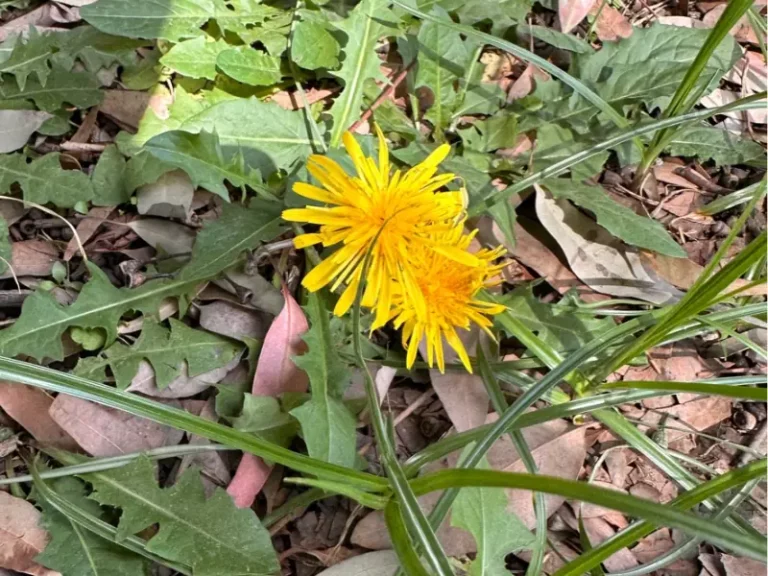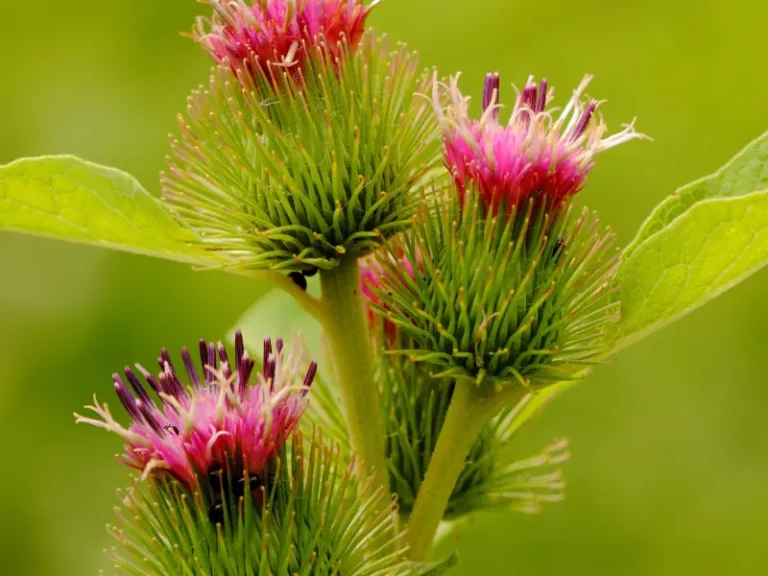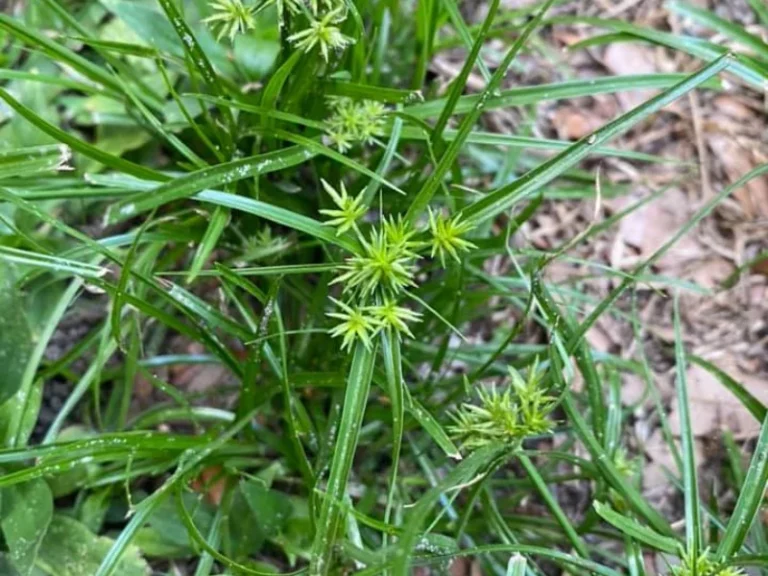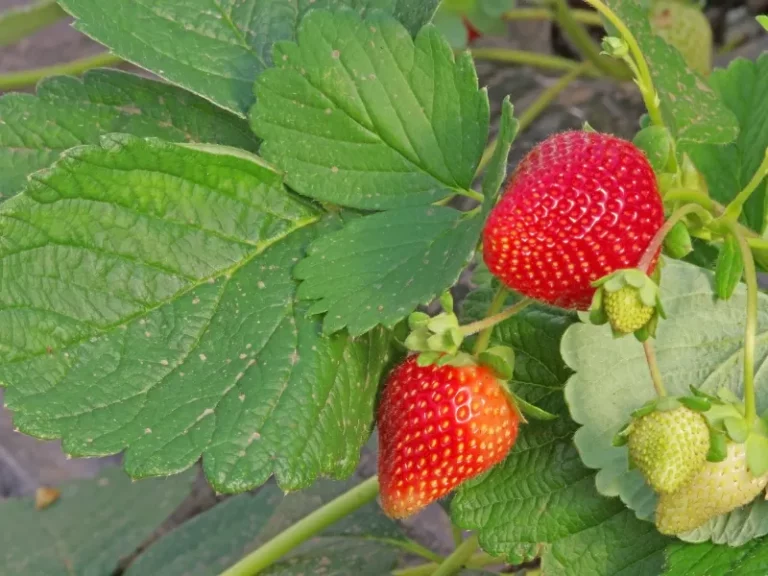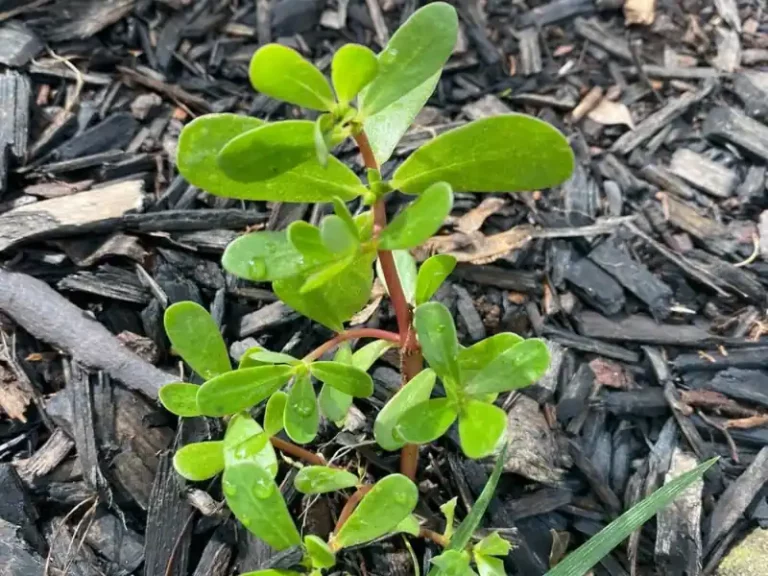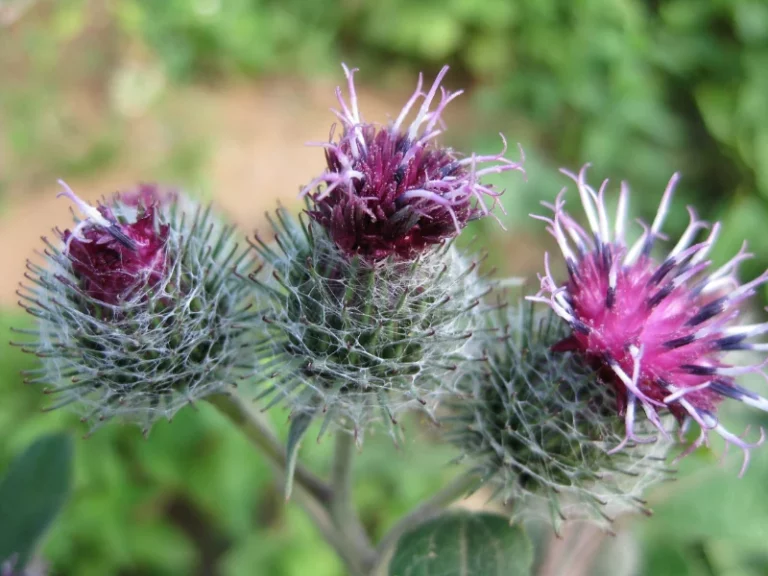Weeds That Look Like Dandelions: How to Identify and Control Them
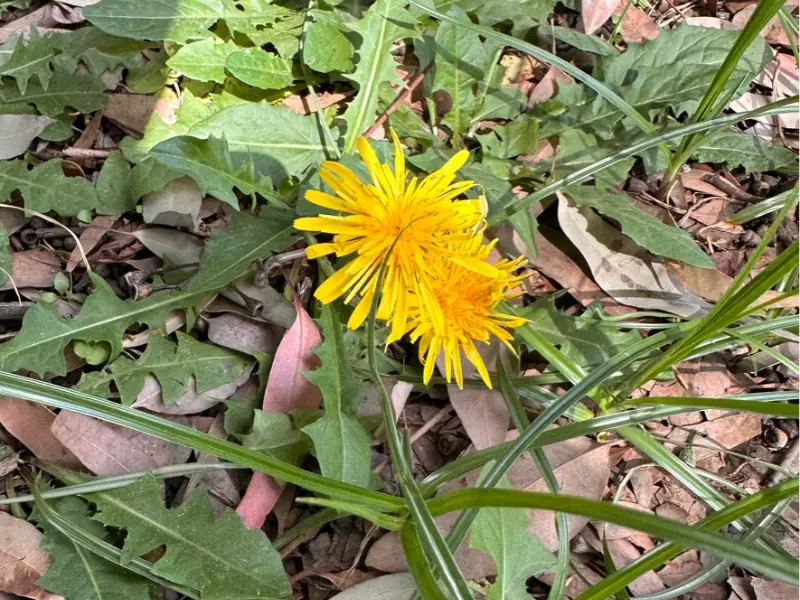
Dandelions are common yellow-flowered plants with fluffy white seeds and deeply serrated, long green leaves that we see in gardens and parks. But did you know that there are other plants that look almost identical to dandelions? These deceptive look-alikes, known as false dandelions, can fool even the most astute observer into believing they are real dandelions.
Weeds that look like dandelions include sow thistle, catsear, narrowleaf hawksbeard, meadow hawkweed, bristly hawkbit, wild lettuce, coltsfoot, autumn hawkbit, coast dandelion, chicory, common groundsel, mountain dandelion, and lesser burdock.
Differentiating between real dandelions and their lookalikes is not only botanically interesting for plant enthusiasts, but it is also important for gardening and weed control practices.
Below, I have discussed some dandelion look-alikes and highlighted how to differentiate them from true dandelions, as well as how to control them.
Weeds that look like dandelions
The most common characteristic I noticed about these dandelion lookalikes is that their flowers resemble dandelions, as do some of their leaves, but not to the same extent. Many of them also belong to the same family as dandelions (Asteraceae), which explains why they share similar characteristics.
To tell the difference, carefully look closely at the flowers and compare them to a real dandelion.
1. Annual sow thistle (Sonchus oleraceus)
First on our list is the sow thistle, also known as colewort, hare’s lettuce, or milk thistle. It belongs to the same family, Asteraceae family, as dandelions.
At first glance, you can mistake sow thistle for dandelions. Both plants have bright yellow flowers at the end of their stems, jagged green leaves, and produce a sticky, milky sap when any part of either plant is cut open.
Additionally, both plants have taproots and share the same seed dispersal mechanism, using fluffy seed heads to spread.
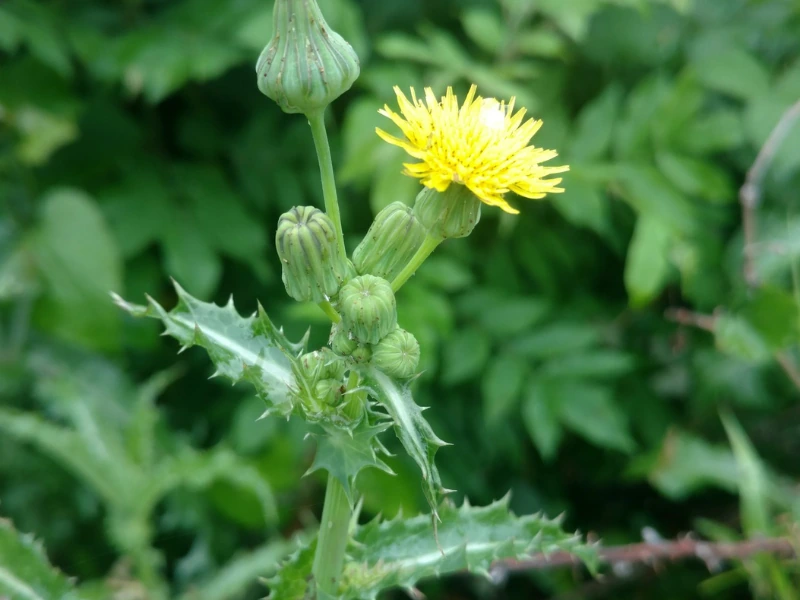
You can differentiate them by looking at sow thistle flowers, which are not perfectly round like dandelions. Dandelion leaves are deeply serrated with pointed tips and grow in a rosette pattern at the base of the plant, while sow thistle leaves often have prickles on the margins and grow alternately on the stem.
Additionally, dandelion seed heads form perfect globes, while those of sow thistle are elongated and cylindrical. The dandelion taproot is also longer than the sow thistle’s.
Sow thistle invades agricultural lands in mid-to-late May when soil temperatures are warm. Despite its medicinal properties, it attracts pests like nematodes.
2. Common catsear (Hypochaeris radicata)
Common catsear, belonging to the Asteraceae family, just like dandelions, is another weed you can mistake for dandelions, especially if you are unfamiliar with the two plants. Both are perennial broadleaf weeds that thrive from fall through spring.
Like dandelions, common catsear has tiny yellow flower clusters that emerge at the end of leafless stems and might confuse you into thinking they are flowers from young dandelion plants.
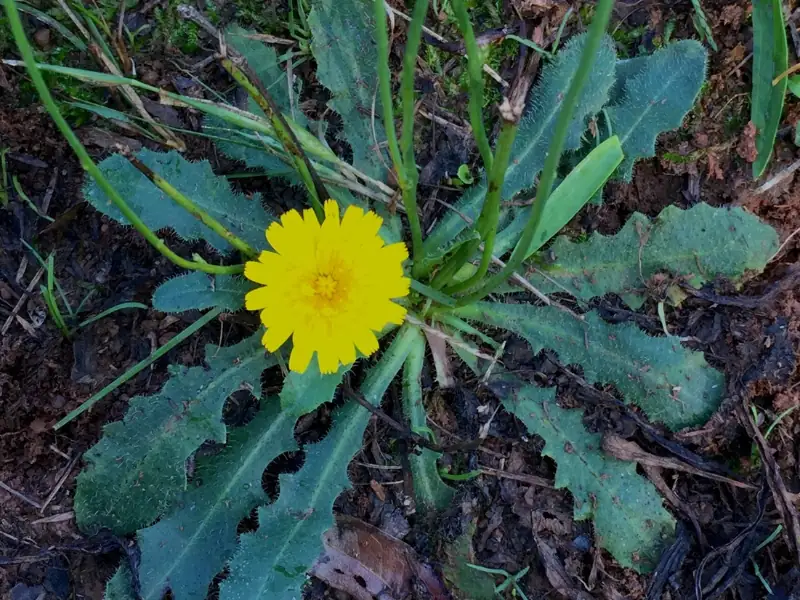
Despite that similarity, you can spot some differences when you compare the stems and leaves of both plants.
- Dandelion leaves are smooth, deeply lobed, and form a rosette at the base of the plant while catsear leaves are irregular, toothed-edged, and hairy.
- The catsear leaves resemble a cat’s ears shape, hence the name “catsear.”
Catsear is pasture for horses, though it might become poisonous if consumed in large amounts.
Control
- Uproot the whole plant, including the roots, or use post-emergence herbicides with Aminocyclopyrachlor + chlorsulfuron as the active ingredients.
3. Narrowleaf hawksbeard (Crepis tectorum L.)
Narrowleaf hawksbeard is another dandelion look alike. It belongs to the Asteraceae family, is tap-rooted, excludes a milky sap when cut, and has bright radial yellow flower heads. Those are just some features that make the narrowleaf hawksbeard weed look similar to dandelions.
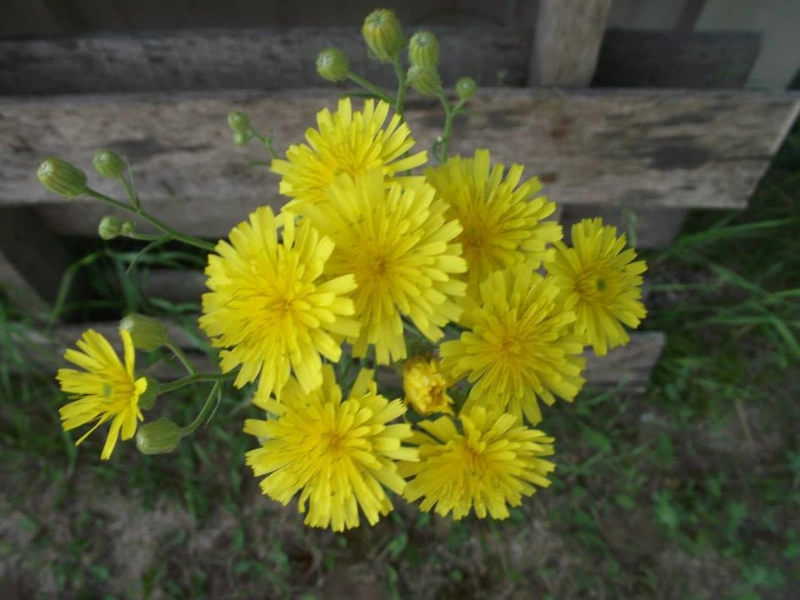
However, here is where the difference comes in:
- Narrow-leaf hawksbeard has shallowly lobed alternate growing leaves and branching, hairy stems that are leafy, while dandelions have a deeply jagged rosette growing leaves and unbranched, leafless stems.
- Narrow-leaf hawksbeard can grow up to 40 inches tall, while true dandelions can grow up to 20 inches tall.
This weed is common in moist and well-lit North American fields and roadsides. It can spread quickly by wind, releasing up to 50,000 seeds per plant.
Control
- Handpull for small infestations or use herbicides with glyphosate or metsulfuron-methyl early in spring when the weed is at its cotyledon stage.
4. Meadow hawkweed (Hieracium caespitosum)
Meadow hawkweed, also known as king devil, is a herb species that bears a resemblance to dandelions in some ways.
Like dandelions, meadow hawkweed belongs to the Asteraceae family, having bright yellow flowers on top of naked, hairy stems. It also has a taproot and exudes a milky sap when broken. At first glance, you might easily mistake it for dandelions.
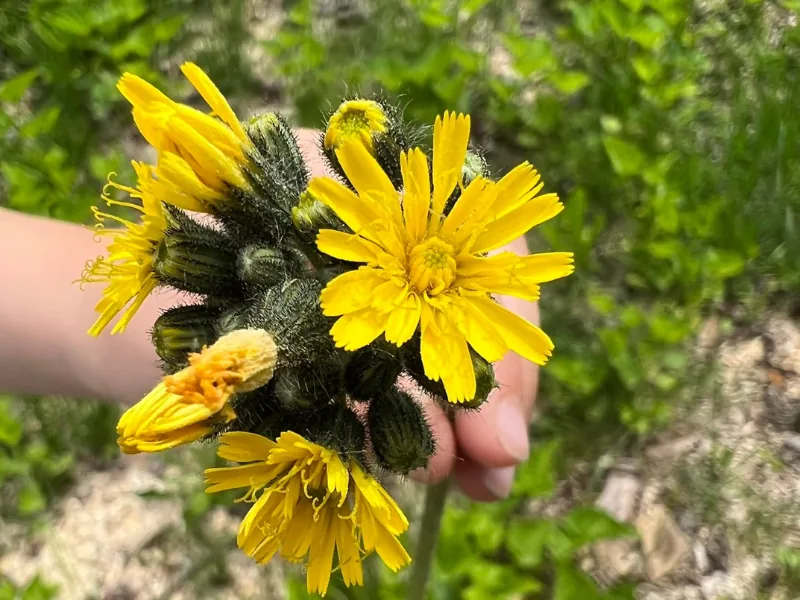
- Dandelion leaves are deeply toothed, while meadow hawkweed leaves are untoothed and spoon-shaped.
- Meadow hawkweed can bear up to 30 small flower heads, while dandelion stems have only one wider flower head per stem.
- Dandelions are shorter than meadow hawkweed, which can reach up to 1 meter tall.
Meadow hawkweed is a native herb of northern, central, and eastern Europe. It thrives in well-drained, coarse soils that are moderately low in organic matter. It prefers full sun or partial shade and spreads rapidly.
Control
- Hand-pull or spray it with herbicide 2,4-D early in the growing season.
5. Bristly Hawkbit (Leontodon hispidus – L.)
Also known as rough hawkbit is another perennial weed related to dandelions since they belong to the same taxonomic family. Because of their relationship, the two weeds share some similarities.
First, both plants have basal leaves that grow from the base of the stem. They also have flowers that grow singly on each stem. Additionally, both plants’ leaves have jagged edges, and the stems are leafless and hairy.
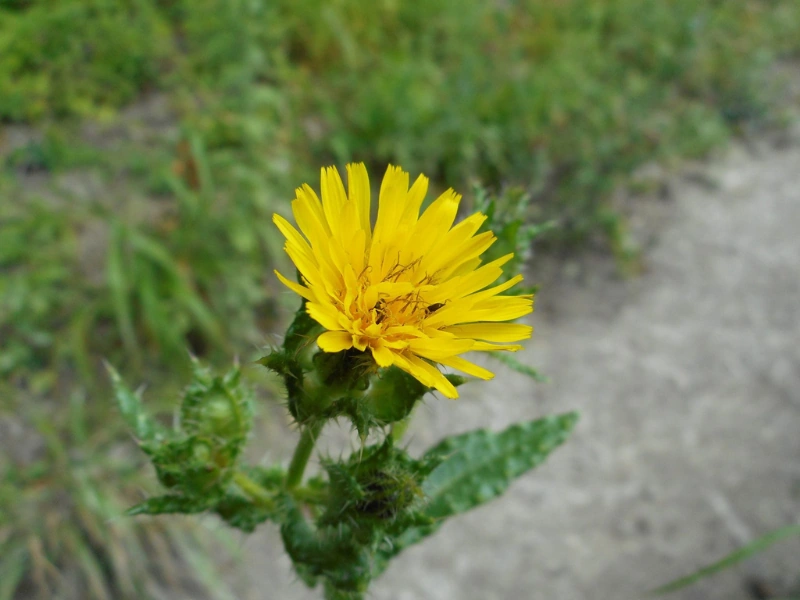
While bristly hawkbit may resemble a dandelion, there are key differences between the two plants. Here are some of them:
- Dandelions have yellow flowers, while bristly hawkbit’s flowers can be orange, yellow, or red-pink.
- Dandelion plants have single, unbranched stems, while bristly hawkbit plants can have multiple, branched stems with flower heads at each end.
- Bristly hawkbit is taller than dandelions, and its leaves are narrower.
Bristly hawkbit prefers sunny and well-drained soils to thrive.
Control
- Uproot or kill small infestations with glyphosate herbicides. Pre-emergent herbicide is the best way to prevent future infestations.
6. Wild lettuce (Lactuca canadensis)
Wild lettuce, also known as bitter lettuce, opium lettuce, and great lettuce, is a winter annual that belongs to the Asteraceae family, just like dandelions. It prefers moisture to survive and can grow to around 7 feet tall, which is taller than dandelions.
Wild lettuce and dandelions have some similarities, like they both have bright yellow flowers that bloom in the summer and die, then both transform into white seed heads. They both prefer slightly acidic soils and well-lit environments.
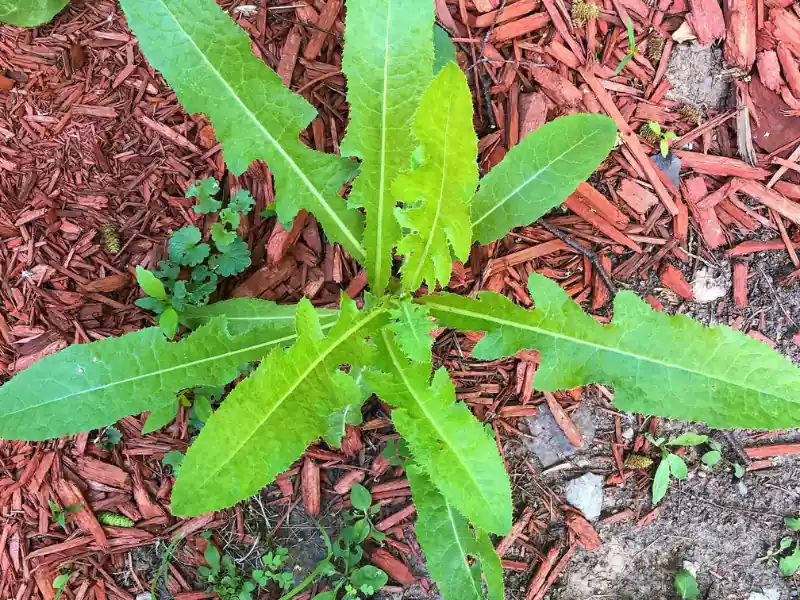
However, there are also some differences between wild lettuce and dandelions:
- Wild lettuce leaves are coarse, dark green, and slightly lobed, while dandelion leaves are light green and deeply jagged.
- Wild lettuce leaves grow alternately on the stem, while dandelion leaves form a rosette at the base.
- Wild lettuce flowers are pale yellow with small seed heads, while dandelion flowers are bright yellow and turn to large seed heads.
Wild lettuce has been used for centuries for its medicinal properties to treat insomnia, anxiety, and muscle spasms.
Control
- Spray glyphosate herbicides in fall or spring to kill the weed.
7. Coltsfoot (Tussilago farfara)
Coltsfoot, also known as cough-wort, horsefoot, sowfoot, and foalfoot, is a perennial herb that belongs to the Asteraceae family. It is a common weed that is found in North America, Europe, and Asia.
Coltsfoot flowers before its leaves are produced, and it has yellow flowers and white seed heads similar to dandelions. The weed can reach a height of 18 inches tall, which is almost the height of dandelions.
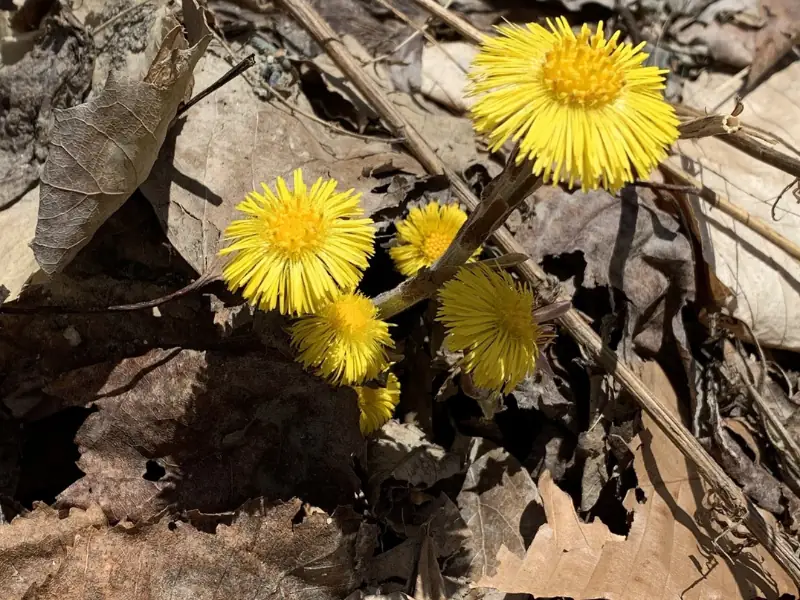
Despite that, here is where the differences occur:
- Flowers: The petals of coltsfoot flowers are more open than those of dandelions, and the flower is more of a cup shape. Dandelion flowers are round.
- Leaves: The leaves of Coltsfoot have spiky protrusions at the margins, while dandelion leaves do not have these protrusions. Coltsfoot leaves are also rounded heart-shaped, while dandelion leaves are more elongated and deeply toothed.
CAUTION: Handle Coltsfoot with caution since pyrrolizidine alkaloids in them can cause liver problems.
Controlling
- Uproot the whole plant or spray it with glyphosate herbicide.
8. Autumn hawkbit (Leontodon autumnalis)
Autumn hawkbit, also known as fall hawkbit, is a perennial plant that blooms during the months of July to September. It produces yellow, daisy-like flowers that are similar in appearance to dandelion flowers. The leaves of both plants are also lobed, and they are both members of the Asteraceae family.
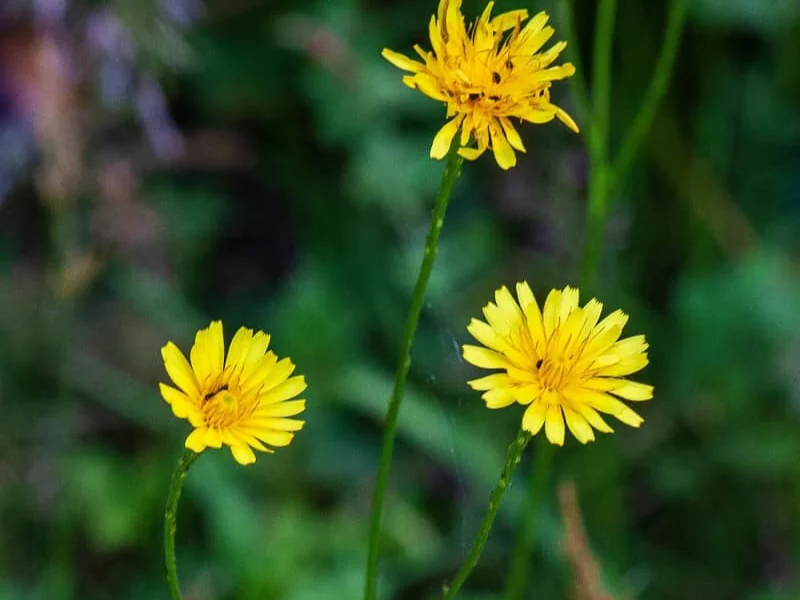
However, if you are a keen observer, you can spot some distinct features that set autumn hawkbit apart from dandelions.
- Autumn hawkbit flowers have scale-like bracts on the flower stalks near the flower heads, while dandelion flowers do not have bracts.
- Autumn hawkbit has branched stems, while dandelions have unbranched single stems.
- Dandelion leaves are also thicker and shallowly lobed than autumn hawkbit leaves.
- Finally, dandelions tend to be taller than autumn hawkbit plants.
Control
- Spray it with dicamba herbicides then mow regularly to prevent its spread.
9. Coast dandelion (Agoseris apargioides)
Coastal dandelions are perennial weeds that look similar to dandelions but are more prevalent on coastal dunes and cliffs. They also go by the name seaside false-dandelion. Like other dandelion look-alikes, coastal dandelions belong to the same taxonomic family (Asteraceae family) as dandelions.
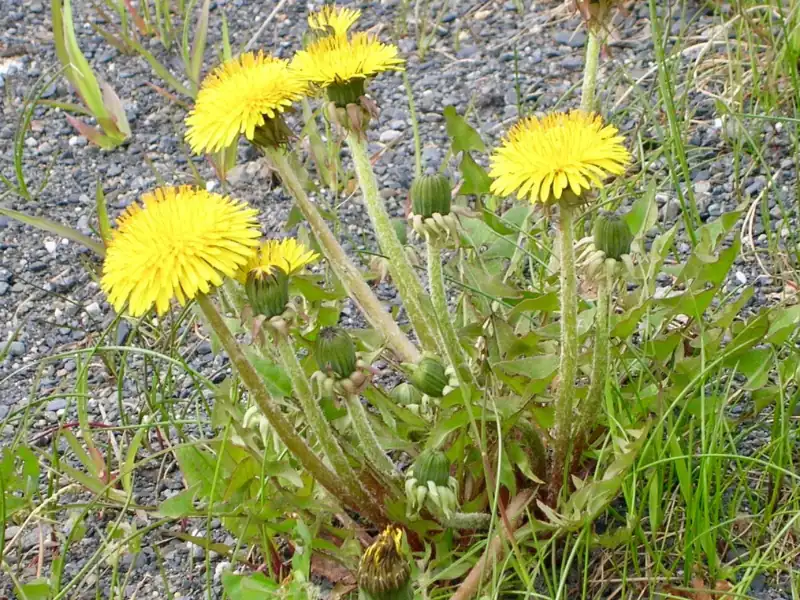
Here is how coastal dandelions are confused for true dandelions. They both form low rosette leaves close to the ground; both produce yellow flowers, green leaves, and slender, long, and unbranched stems.
However, here is where the difference becomes apparent:
- When cut open, coastal dandelions produce a milky orange sap, while dandelions produce a white milky sap.
- The flowers of coastal dandelions have a purple line on the lower surface of the outer petals, while dandelion flowers do not have this line.
- The leaves of coastal dandelions have rounded lobe margins and are slender at the stem stalk and broaden towards the tip, while dandelion leaves have elongated, deeply jagged leaves.
Coastal dandelions are lawn weeds that grow on sandy spots in your backyard.
Control
- Uproot them or spray a herbicide such as Bonide Weed Beater Lawn Weed Killer Concentrate during fall.
10. Chicory (Cichorium intybus)
Chicory is a weed that looks similar to dandelions but has some differences. Like dandelions, chicory belongs to the Asteraceae family and has a large, brown, fleshy, branched taproot with a milky sap.
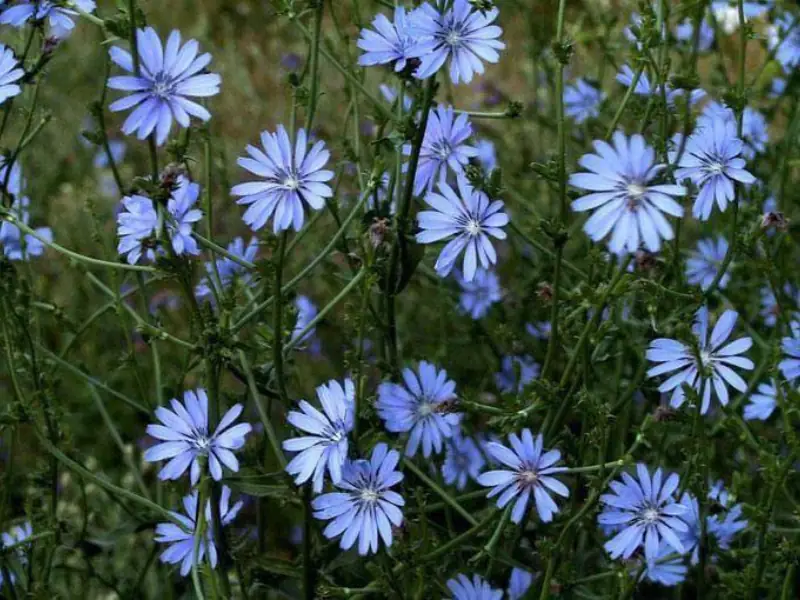
However, chicory has several distinguishing features that set it apart from dandelions.
- Height: Chicory can grow up to 50 inches tall, while dandelions typically reach a height of 20 inches.
- Flowers: Chicory flowers can be blue, blue-purple, or white, while dandelion flowers are always yellow.
- Stems: Chicory stems are thick and fibrous, while dandelion stems are slender.
- Leaves: Chicory leaves come in two shapes: large, dandelion-shaped leaves near the base of the stem and small, oblong leaves along the length of the stem. Dandelion leaves are only one type of shape, which are elongated and deeply serrated.
- Leaf arrangement: The leaves of chicory are not always opposite one another, and they always point away from the rosette. Dandelion leaves are always opposite one another.
Chicory is a common weed found in many habitats, including lawns, gardens, fields, and roadsides. It prefers well-drained soil and full sun. Chicory can be controlled by uprooting the whole plant, including the roots.
Here are some additional facts about chicory:
- The chicory roots can be roasted and ground to make a coffee substitute.
- Chicory leaves can be eaten in salads or cooked like spinach.
- Chicory is a good source of vitamins A and C, as well as fiber
11. Common groundsel (Senecio vulgaris)
Common groundsel is a perennial herbaceous weed belonging to the Asteraceae family and produces yellow flowers like dandelions. The flower heads of the two plants almost look similar. The stems are erect, and their height is almost identical.
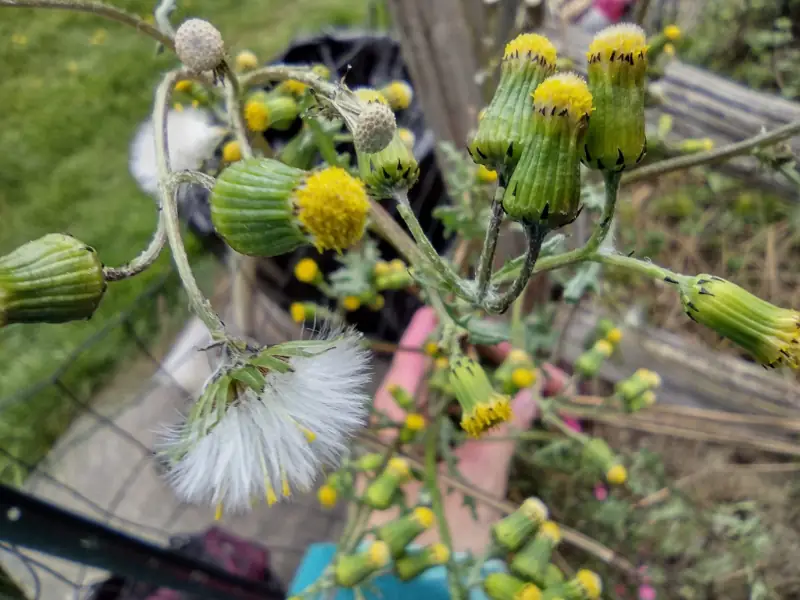
However, there are some differences between the common groundsel and dandelions:
- Dandelion flower heads are larger than those of common groundsel.
- Common groundsel stems are erect but highly branched, while dandelion stems are unbranched.
- The leaves of common groundsel are alternate, irregularly lobed, and have coarsely toothed margins, while the leaves of dandelion are in a rosette form, regularly lobed, and have smooth margins.
Common groundsel is among the most common and problematic broadleaf weeds in nurseries and greenhouses. It is also toxic to cattle, swine, and horses and causes serious liver damage to them if ingested. The weed prefers moist, loamy, fertile soils, but it will grow in sandy soil or heavy clay and infertile soils but does not grow in shade.
Control
- Use a 3-inch mulch to prevent its seeds from sprouting, or use herbicides containing glyphosate.
12. Mountain dandelion (Agoseris Glauca)
Mountain dandelions are perennial weeds that are mostly found in the montane, alpine, and subalpine zones on foothills. They share some similarities with dandelions but also some differences between them.
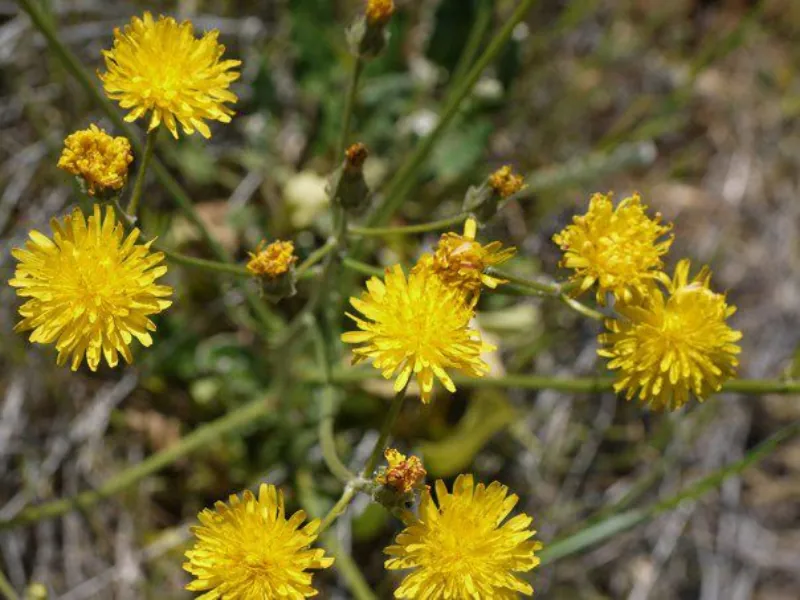
Similarities to dandelions:
- Both mountain dandelions and dandelions produce milky juice when they are cut open.
- Both plants have an erect leafless stem.
- The leaves of both plants emerge from the base.
- The seed head of both plants is white and hairy.
Differences from dandelions:
- Mountain dandelions are taller than dandelions, reaching up to 30 inches in height, while dandelions typically only reach 20 inches.
- The leaves of mountain dandelions are smoothly margined, while dandelion leaves are deeply serrated.
- The leaves of mountain dandelions are also shorter than those of dandelions.
Mountain dandelions are found in various habitats, including meadows, forests, and roadsides. They are most common in areas with well-drained, sandy soil. Mountain dandelions are native to North America but have been introduced to other parts of the world, including Europe and Asia.
Control: Mountain dandelions can be controlled by hand-pulling, mowing, or using a herbicide.
Medicinal uses: The milky sap of mountain dandelions have been used to treat warts and sores. It is also said to have anti-inflammatory and diuretic properties.
13. Lesser burdock (Arctium minus)
Lesser burdock is a biennial, herbaceous wild flowering plant that belongs to the Aster family. It is also one of the weeds that stick to you. It is often mistaken for dandelions because it has similar features.
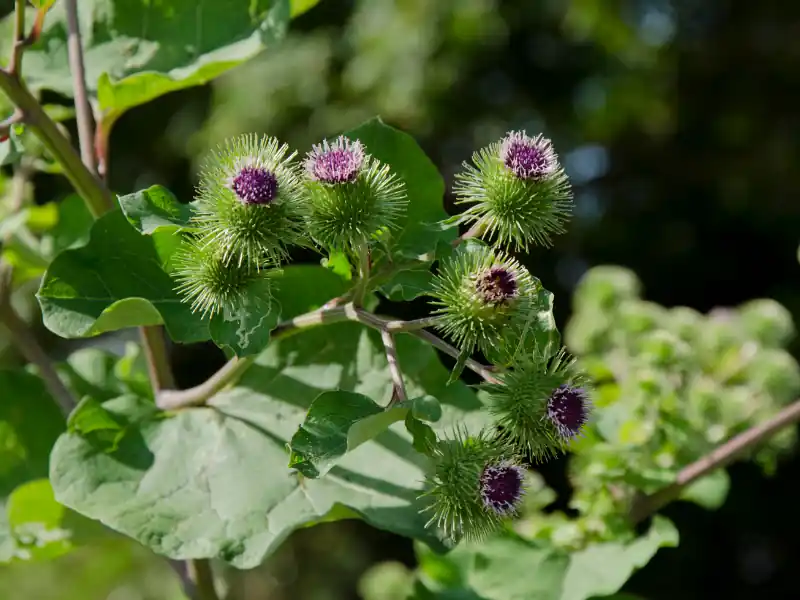
Here are some of the similarities between lesser burdock and dandelions:
- They both have dense rosette-growing leaves.
- They both have a milky sap that oozes out when the leaves are broken.
- They both have a taproot.
However, there are also some key differences between lesser burdock and dandelions:
- Lesser burdock is taller than dandelions, reaching up to 6 feet tall.
- Lesser burdock has branched stems, while dandelion stems are unbranched.
- The leaves of lesser burdock transform to a heart-shaped form as the plant ages, while dandelion leaves do not.
- The flowers of lesser burdock can vary in color, including pink, lavender, purple, or white, while dandelions only have yellow flowers.
Lesser burdock has a complex spreading mechanism by seed, a single plant producing almost 15,000 seeds. It can take over your lawn within no time, destroying its aesthetic appeal. It is also difficult to eradicate.
Lesser burdock is also susceptible to powdery mildew and root rot, which can cause harm to agricultural plants.
Control
- Hand-pull the plant but wear gloves while handling it or spray it clopyralid + triclopyr herbicide between rosette and bloom stages.
FAQs
1. How can I tell the difference between dandelions and false dandelions?
True dandelions have more petals (20-30) and deeply serrated leaves, while false dandelions have fewer petals (10-15) and less deeply serrated leaves. True dandelions typically have a single stem with a single flower, while false dandelions can have multiple stems with multiple flowers.
2. Are false dandelions harmful to my garden or lawn?
False dandelions are not poisonous, but they can be invasive. This means they can spread quickly and crowd out other plants in your garden or lawn. If you have a lot of false dandelions in your yard, it is best to remove them to prevent them from taking over.
3. What is the best way to get rid of dandelions and their look-alike weeds without using harmful chemicals?
Some of the most effective methods to get rid of dandelions and their look-alike weeds include hand-pulling, mulching, soil aeration, watering deeply, spraying with vinegar, and boiling water. These methods are all safe for your plants and the environment.
References
- University of California: Dandelion
- University of California: Pest in Gardens and Landscapes. Dandelions

